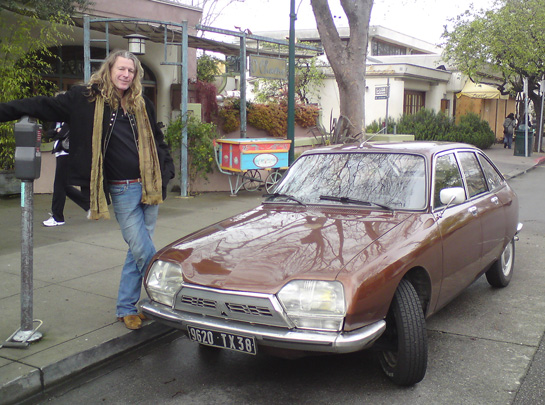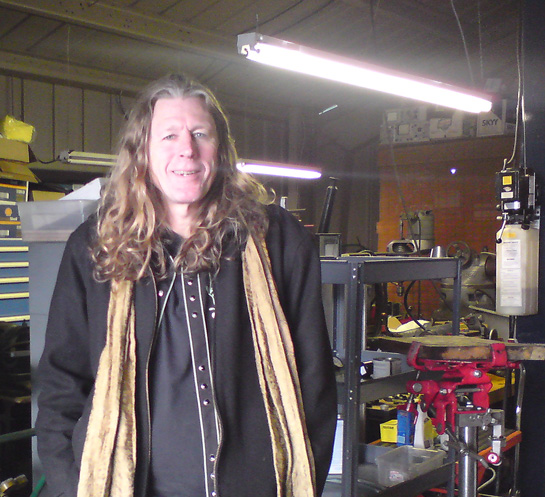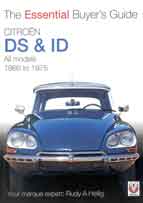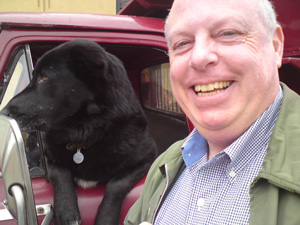
Why Citroën? Jaan Horth, the proprietor of a shop called Eddins Moto, offers insight. Photo by Petya Elitch.
Brandy Elitch on the Enigma that is Citroën
For many American collectors, the French automobile industry is an enigma. France is in many respects the birthplace of the automobile, and has produced advanced cars since the turn of the century.
As Pete Vack has recently reported in his review of the late Griff Borgeson’s research, the 1912 GP Peugeot, designed by Ernest Henry, is the progenitor of all modern high performance motors. Before 1940, the French automobile industry created the truly great marques of Hispano-Suiza, Bugatti, Voisin, Delage, Delahaye, Talbot, and Panhard.
But by 1960 none of the great names survived. As G.N. Georgano reports in his landmark volume, “A History of Sports Cars,” (EP Dutton, 1970, NY, NY), this unhappy result was largely the result of a deliberate attempt by the French government to marginalize the producers of luxury goods. First, there was punitive taxation. Added to that the government determined, via a National Plan, which cars a manufacturer could produce. For example, after the war Hotchkiss developed a small car, the successor to the Amilcar-Compound. The government bureaucracy determined that the other manufacturers were already making enough “cheap family cars” and that Hotchkiss could only make expensive cars, a decision which inevitably doomed them to failure.
Post War Rebirth
While the great luxury marques faded out of existence, the Big Three, Citroën, Renault, and Peugeot thrived. This is true particularly in the postwar period, which today the French call “Les Trentes Glorieux,” – the thirty great years of rebirth, after a devastating war which left the country in ruins. And of these three marques, it is Citroën which is indisputably the design leader. Even the malevolent Louis Renault stated that Andre Citroën (whom he referred to as “the Jew of Javel”) always forced the other manufacturers to follow him. As Pierre Dumont states in his book, “Citroën, the Great Marque of France,” (Interauto, 1973, London, England) “There is no doubt that Citroën was always ahead of both his direct competitors and the manufacturers of more sophisticated vehicles in everything that concerned production, with all the consequent implications on the design of the vehicle, whenever necessary…More than any other, Citroën brought fresh ideas into all the fields covered by the automobile industry… What manufacturer, whether French or foreign, of whatever epoch, can boast of having so much influence on general automobile design? None, with the exception of Daimler, with his first Mercedes in 1901…The 2cv, the DS, the SM, and the GS have, as much as the Type A and the Traction Avant, brought fresh ideas into the automotive world.” In short, it is this tradition of research, innovation, and progress that marks the history of the marque of the Double Chevrons (a symbol of the double helical gearset which Citroën invented for automotive use).
A French Goddess
Most Americans, if they are aware of Citroën at all, think of the DS when the name is mentioned. People who have not studied the grand sweep of automotive design and history are often surprised to discover that the DS is considered one of the greatest designs in the history of the automobile. The DS (when pronounced in French, sounds like the word “deese,” which means “goddess”) went into production in 1955, and was in continuous production until 1974, by which time over 1.4 million had been produced. As the historian Graham Robson has written (Collectible Automobile, August 1994, Lincolnwood, IL), “The D series bowed at the Paris Salon in October, 1955, and promptly caused a sensation. Even now, it would be difficult to imagine a new model that could provoke as much comment on its public unveiling…It was almost something from another world, as if alien designers had looked at Earth’s motor cars, found them wanting, and decided to demonstrate their ideas of what a truly modern automobile should be…For the next two decades, it remained arguably the most technically advanced car in the world. It boasted more innovation, more technical wizardry, and more sheer complexity than any previous family car.” In 1975, the D was replaced by the CX, another sophisticated design, which was produced until 1989, and the debut of its successor, the XM. Robeson concludes, “It’s the Goddess that most people still regard as the definitive big Citroën (along with the Traction Avant). In their eyes, it remains a car whose genius will never be matched.” I agree – I have owned my D since 1969.

Somewhere behind Jaan is the much sought after French lathe bought from Aston Martin.Photo by Petya Elitch.
Citroën in America
What if you wanted to buy a Citroën? Where would you find one, and equally relevant, who would you get to work on it? Well, you would have a tough time finding a car in the US – Citroën sales in the US didn’t even average 2000 cars a year for some years. And, as far as the postwar cars are concerned, rust is a big problem.
It would not be advisable to buy a car with any rust on it whatsoever. The hydropneumatic system is quite reliable, but it would be preferable to buy a car manufactured after mid-1969, when the conversion was made from brake fluid (hydroscopic=bad, LHM=good) to mineral, LHM green fluid, which is not hydroscopic. The motors are also reliable, except for the SM, of course. That is a shortened version of a Maserati V-8, which chief engineer Alfieri converted to a dohc 90 degree V-6 with 3 two barrel Webers, and then turned it around (it’s front wheel drive) so the gearbox is in front of the motor. The good news is that parts are not a problem, as almost any part is available through a company called Western Hemispheres, located in Santa Cruz, CA. There are also many parts sources in France, which can be found by getting a copy of the weekly auto newsmagazine “La Vie de L’Auto “(the next time one of your friends goes to France for vacation, demand that they go to a kiosk and bring you back the latest copy). Most cars were sold here in California, and there are still shops here that cater to the marque, principally in Southern CA. However, any good mechanic can work on a Citroën, with the possible exception of the SM.
Restoration
In northern California, the epicenter of automobile restoration is Berkeley. Since we are talking about Citroën, I thought it would be interesting to interview one of the “wizards of Berkeley,” who has recently tackled a couple of Citroën restorations. This person is Jaan Horth, the proprietor of a shop called “Eddins Moto.” (see www.eddinsmoto.com). Due to space constraints here, I am not going to recount some of his fascinating stories – you can find them on his website. Suffice to say he is not only a good mechanic; he is a good storyteller too! Normally, Jaan is restoring high dollar Ferraris, Maseratis, and Lamborghinis, but recently, he decided that he wanted a Citroën GS for his everyday use. This necessitated a trip to France, where he found a nice, original car (not easy to do anymore, as the French tend to scrap cars that are more than fifteen years old, and you will certainly not see 20 year old cars on the roads over there). He sold it to a customer, who trashed it, so then he had to find a replacement motor. It turns out that the same motor was made in Romania, for a Citroën joint venture, called “OldCit.” He imported a car from Romania, but it turns out that those cars didn’t have the hydropneumatic suspension, so he had to adopt the high pressure pump for the replacement motor.
This story is recounted on his website, where it makes fascinating reading, and shows the lengths to which a real restoration shop will go to in getting something right the first time. When I visited with Jaan a few weeks ago, I asked him what was different about working on a production car versus his normal clientele. His answers were surprising. First, he said that, for a shop in Berkeley, it is often easier to get parts for a low production, exotic Ferrari than for a 35 year old series production car like the GS. Second, he said that, when it comes to working with car collectors, a person who owns a $10,000 car will always pay the bill, and person who owns a $500,000 car will never pay the bill. Over the years, he has learned to live with this by charging a retainer up front. Another insight into the world of car collecting! To give you an idea of Jaan’s passion, when he was young he saw a picture of a French lathe, and he decided right then and there that he would have one. Eventually, Aston Martin decided to sell one that they used to manufacture the DB5, and he bought it, shipped it to the US, and installed it in his shop. Here is a person who is truly passionate about his craft, and this is the kind of person you want working on your car, no matter what it is.


Jaan, good to see you here ! How are the Lancias doing ?
This is one of my favorite pieces in Veloce Today. It is the type of piece that you would not find in another place.
Brandy,
Yet another excellent French history lesson! The DS is so well respected beyond our borders that some 400o examples overwelmed Paris for the 50th anniversary event in 2006! I believe that event to be the largest single-platform collector car reunion ever! There now is some discussion that the SM Maser V6 was derived from an earlier stillborn V8 design by Alfieri, then shorted, as the chains and gear arrangement is rather different (and less successful?) than the V8 classic. Insight, anyone? Also, nice “mug-shot,” Petya!
Gianni
Pete,
Where do you get your Citroen DS serviced in Berkeley ?
I am looking for a mechanic.
Thanks.
We’ve asked Brandes Elitch to help…
Editor
To Bob Blair – if you’re in Berkeley and have a Citroen – especially a DS/SM/2CV/Traction, I may be able to help. I’m a retired automotive new applications development engineer with 30 yrs as consultant to the world’s auto co’s, and have been driving DSs since 1962 – starting in Utah, when my father brought home a ’58 DS19 Citromatic and we cut our teeth on that car. I now have a ’65 DS19 Citromatic in San Jose, awaiting my repairing the trunk, now smashed, by an idiot lawyer texting as he rear-ended me on 580 in broad daylight. Yet I was able to drive home unaided after using high body position to pull the trashed bumper out of the left rear tire. Been doing all my own work for 54 yrs now, making tools/parts as necessary, adapting modern ones in some cases for better reliability/cost reduction. Was most recently a “professional trainer” on Citroen restoration for a gentleman in Mountain View who accosted me on a Palo Alto street in my ’65 as he’d been lusting after one his whole life – car now running nicely. Past Pres. of the Chicago Citroen Club, ’68/’76, attended the 50th in Paris with 4000 other owners, now using my Citroen experience to restore anything from ’65 Mercedes 600 hydraulic window system to my ’61 Panhard PL17 cabrio or ’64 Bristol 408. I’m often on the DS/ID yahoo chatline and SM site also. Give me a call anytime – Ken 248-515-9879